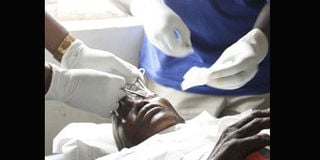WHO: This is what Kenya needs to do to win war against NTDs

A woman undergoes an operation to treat trachoma, an eye disease caused when the eye is infected with Chlamydia trachomatis. PHOTO | FILE | NATION MEDIA GROUP
What you need to know:
- Trachoma, the leading infectious cause of blindness worldwide, is still a headache to many Kenyans especially in pastoral communities.
- Sleeping sickness is transmitted through the bite of infected tsetse flies, causing fever, headaches, joint pain, itching, and sleep disturbances. Left untreated, it can be fatal.
The World Health Organization (WHO) has urged Kenya to prioritise treatment and stocking up on medicines for neglected tropical diseases(NTDs).
This is after the Health Ministry led by CS Susan Nakhumicha submitted to the global health authority a five-year master plan on how it intends to eradicate NTDs.
The recently launched masterplan includes a draft dossier for the certification of the elimination of Human African Trypanosomiasis (HAT) as a public health threat.
Speaking at the 14th Kenya Medical Research Institute annual scientific and health conference , Dr Pauline Mwinzi, the WHO regional advisor for schistosomiasis (bilharzia) and neglected zoonotic diseases in the Africa region, noted that they have received Kenya’s master-plan. “Integrating this disease into mainstream healthcare systems is a strong strategy. The diseases have prevailed due to neglect.
“You cannot find drugs for NTDs even in major health facilities because these diseases are not being prioritised,” Dr Mwinzi added.
The expert pointed out what makes Kenya’s master-plan different from what it presented to WHO in 2015: “Unlike the past ones, this one has an incredible sustainability component, does not only look at diseases in humans but how diseases jump from animals to humans from a one-health approach.”
Dr Mwinzi further urged the Kenyan government to fully fund NTD programmes. “Largely, funding, which is in millions of dollars, comes from donations. It is possible to start moving away from donor supported programmes,” she said.
According to Dr Mwinzi, trachoma, the leading infectious cause of blindness worldwide, is still a headache to many Kenyans especially in pastoral communities.
The infection is transmitted by direct or indirect transfer of eye and nose discharges of infected people, particularly young children who harbour the principal reservoir of infection. These discharges can be spread by particular species of flies.
“It affects many pastoralist communities largely because of poor sanitation practices,” Dr Mwinzi said. She added that the African Region accounts for 40 per cent of global NTD burden, mostly affecting poor communities.
“All 47 countries in the African Region are endemic for at least one NTD, and 37 are co-endemic for at least five,”Dr Mwinzi told delegates.
She noted that the regional framework 2022-2030 for elimination and control of tropical and vector-borne diseases envisions the elimination of one NTD in at least 16 countries between 2021 and 2030. She further highlighted how the climate crisis is fuelling the spread of NTDs in Kenya and the African region.
She acknowledged that increased weather events are limiting the capacity of health services to effectively respond to disease; thus undermining Universal Health Coverage and disrupting health systems, widening health inequalities and threatening to undo monumental achievements in global health.
Dr Mwinzi thus called for a multisector approach in dealing with how the climate crisis is fuelling the rise of NTDs in the region.
She cited sleeping sickness, saying it is transmitted through the bite of infected tsetse flies, causing fever, headaches, joint pain, itching, and sleep disturbances. Left untreated, it can be fatal.
As temperatures rise, making higher altitudes and cooler regions more suitable for the tsetse fly, modelling predicts a shift in its geographic range to areas that were once considered safe from the disease. According to Uniting to Combat NTDs, a global advocacy organisation, without action, an additional 46-77 million people could be at risk of sleeping sickness by 2090.
“We need to involve other sectors like veterinary services and Water ministry. If everyone is brought on board, the burden of NTDs will not be so huge,” said Dr Mwinzi, adding that integrating climate resilience into health systems is critical. She said by predicting shifts in disease patterns, the country can plan ahead, enhancing existing health infrastructure, investing in research, fostering cross-sector collaboration and deploying resources where they’re needed most.





